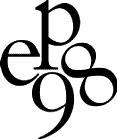
EP98 TUTORIALS
TUTORIELS de la conférence EP98
Saint-Malo, 1-4 April, 1998

| Tutorial EP1 | Introduction to SGML and XML |
| Tutorial EP2 | Advanced XML |
| Tutorials EP3 and EP4 | DSSSL & XSL |
| Tutorial EP5 | Encoding Information for Interchange: An Introduction to the TEI |
| Tutorial EP6 | Mapping Websites and Creating Site Maps |
| Tutorial EP7 | Website Information Architecture |
| Tutorial RIDT1 | Modern Colorimetry (registration possible through EP98 registration). |
The first module is an introduction to the concepts, components and syntax of the ISO standard Document Style Semantics and Specification Language (DSSSL - ISO/IEC 10179) and related Extensible Stylesheet Language (XSL - W3C). Also included is the relationship of these standards to the Standard Generalized Markup Language (SGML - ISO 8879) and Extensible Markup Language (XML - W3C) families of standards.
The second module builds on the knowledge of DSSSL and XSL concepts with hands-on exercises to practice the techniques. The exercises include the use of both standardized style semantics and custom SGML transformation semantics.
This seminar will review the steps in planning and executing a sound information architecture for both public Internet sites and private corporate Intranets.
Ph. Louarn - Jan. 1998 - © Irisa 1997-1998